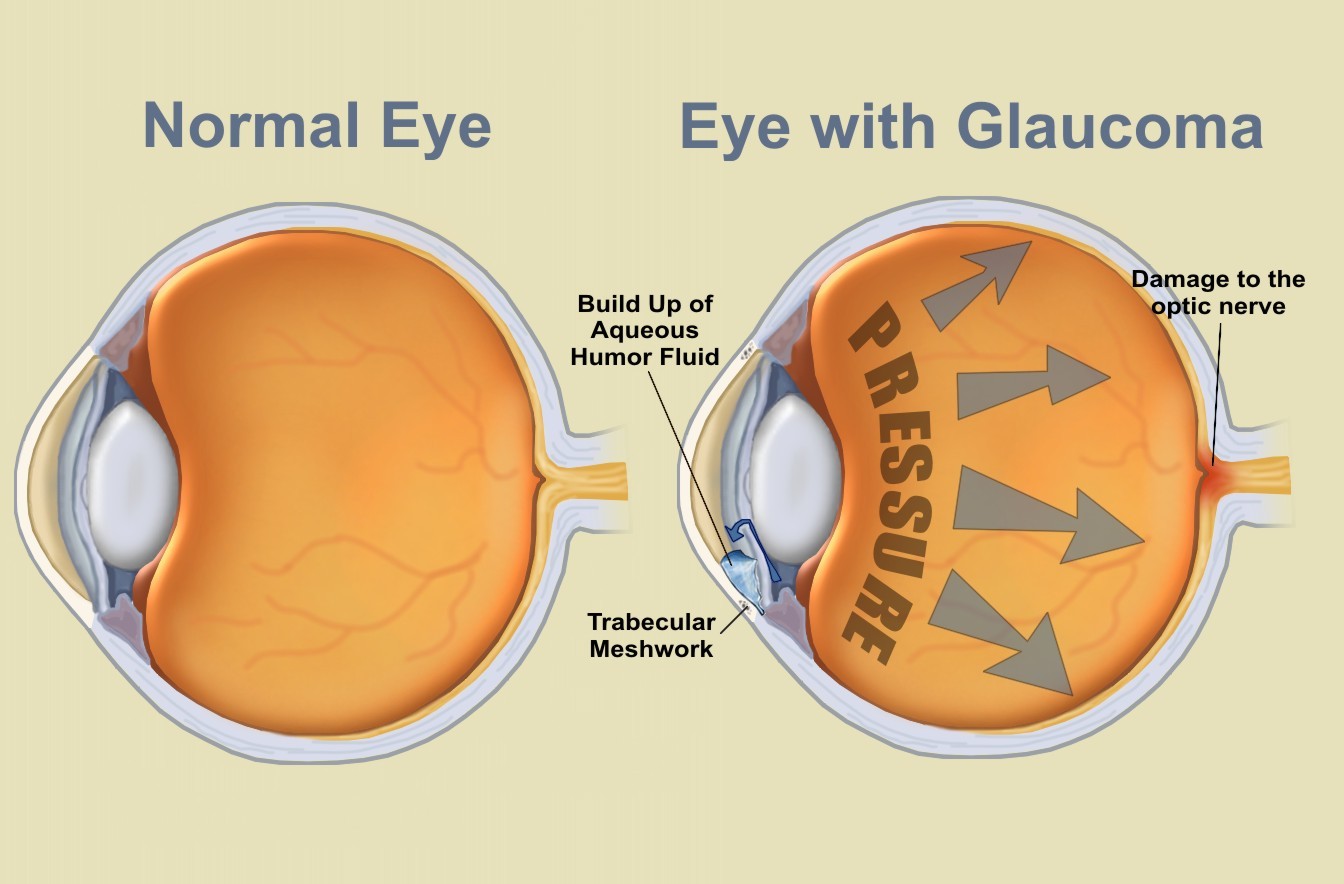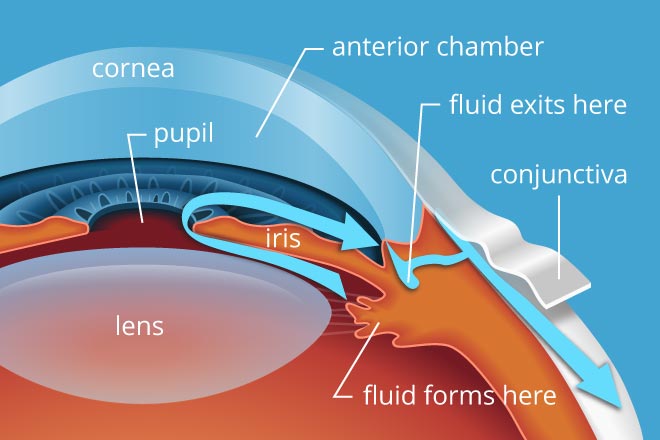What is Glaucoma?
It is an eye disease which damages your eye’s optic nerve, Glaucoma is caused by increasing pressure in your eye. Usually, the disease happens because of built up pressure in your eye. Moreover, the main cause of this pressure in your eye is the build up fluid in the front part of your eye. This extra fluid is responsible for increasing pressure in your eye. Thus, it leads to the happening of glaucoma. The disease can get worse by time.
Moreover, glaucoma tends to be inherited disease that may not show up in early age. But, it usually shows up in older age. The disease apparently damages your eye’s optic nerve. As we know that optic nerve is responsible for transmitting images in the brain.
If the optic nerve gets damaged due to intraocular pressure, the retinal ganglion cells undergo a slow process of cell death termed apoptosis. Therefore, the death of the retinal cells and degeneration of the nerve fibers may lead to a permanent vision loss.
Above all, most of the people have no early symptoms and pain. Usually, glaucoma shows up when you are above 40. So, if you have a family history of glaucoma then you should visit a doctor for a complete eye examination.
Causes
As explained above, Glaucoma is caused by increasing pressure in your eye. This high fluid pressure in your eye happens when the liquid in the front part of the eye doesn’t circulate the way it should.
Your eyes behave like a sink where fluid flows out but when the sink gets blocked it affects the whole drainage system. The same is the case here.
There is a mesh-like channel which is responsible for flowing out the fluid, called aqueous humor. Therefore, if this channel gets blocked, the liquid builds up that result in causing glaucoma.
However, there are no authentic experimental proofs about the reason for this blockage, but doctors have some claims about glaucoma.
More Common Cause (Inherited)
According to doctors in most cases the disease is inherited, meaning it’s passed from, parents to children.
Less Common Cause
There are also some other causes of glaucoma which include blocked blood vessels inside the eye, a blunt or chemical injury to your eye, severe eye infection and inflammatory conditions.
Almost every disease has some symptoms which give clues that something abnormal is happening. Likewise, glaucoma has also some symptoms. Therefore, whenever you notice these symptoms in your eyes you should visit your doctor for your eye test. However, on the other side glaucoma does not show any prominent or noticeable symptoms except the loss of peripheral, or side, vision. That’s why glaucoma is often called the “sneak thief of vision.”
Symptoms
Occasionally, this intraocular pressure inside the eye can rise to severe levels. This can result in sudden eye pain, blurred vision, headache or the appearance of halos around lights.
Seek immediate medical care if you have any of the following symptoms:
- Eye pain
- Vision loss
- Redness in eye
- Seeing halos around lights
- Hazy eye
- Nausea
- Vomiting
- Narrowed vision
Types of Glaucoma
There are two major types of glaucoma:
Primary Open Angle Glaucoma or Wide-Angle Glaucoma
Usually, happens in people who have optic nerves that are sensitive to normal eye pressure. That is why such people have a higher risk of getting glaucoma than normal. In this case, the trabecular meshwork (Drain structure) looks normal, but fluid doesn’t flow out like it should. Moreover, this type of glaucoma is painless and causes no vision changes at first.
Angle Closure Glaucoma or Chronic Angle Glaucoma
This type of glaucoma affects your eye’s drain structure by making the angle between your iris and cornea too narrow. So, your iris is in the way.
Therefore, it can cause a sudden build up of pressure in your eye which further results in narrow-angle glaucoma. This is called an acute attack. Moreover, it is also linked to farsightedness and cataracts, a clouding of the lens inside your eye.
In this case, you should immediately visit your doctor as it is a true eye emergency case.
Listed below are the signs of an acute angle-closure glaucoma attack:
- A sudden blurriness in your vision
- Severe pain in your eye
- A headache is the most usual symptom
- Nausea: feeling sick to your stomach
- Vomiting
- You see rainbow-colored rings or halos around lights
See Also: Best Ten Food for Healthy Eyes: Healthy diet for healthy Eyes
Diagnosis & Treatment of Glaucoma
Diagnosis of glaucoma is very simple and painless procedure. It consists of few tests, in which initially your eye doctor will use drops to open (Dilate) your pupils. After that, he will do vision test and examine your eyes (Optic nerve) and if you have glaucoma, it will show up in a certain way.
Moreover, taking photographs of the nerve will help him in tracking your disease over time. Subsequently, tonometry test and visual field test will be done to check your eye pressure & to figure out if you’ve lost your side, or peripheral, vision. Glaucoma tests are simple, painless and take very little time.
There are three major types of treatments for glaucoma
- Eye Drops
- Laser Surgery
- Micro Surgery
You should better take advice from your doctor about the treatments and which will be suitable for your condition. We are giving a brief description of these treatments.
Eye Drops
The main purpose of using eye drops is to either reduce the formation of extra fluid in the eye or increase its outflow. Eye drops have also some side effects that may include redness, allergies, blurred vision, stinging and irritated eyes.
Make sure that your doctor knows about the medications you are allergic to. Moreover, some glaucoma drugs may affect your heart and lungs.
Laser Surgery
The laser surgery has 3 major procedures (1) Trabeculoplasty: Opening the drainage area, (2) Iridotomy: Let fluid flow more freely by making a tiny hole in the iris, (3) Cyclophotocoagulation: Reducing fluid production by treating areas of the middle layer of your eye.
Micro Surgery
Micro Surgery allows the doctor to create a new channel to drain the fluid and ease eye pressure by a procedure called a trabeculectomy. Sometimes this form of glaucoma surgery can be risky, maybe fails and has to be redone.
Usually, a tube is implanted to help draining fluid. Surgery can cause temporary or permanent vision loss, as well as bleeding or infection. Open-angle glaucoma is frequently treated with various combinations of eye drops, laser trabeculoplasty, and microsurgery.
Infant or congenital glaucoma means that you are born with it. It is primarily treated with surgery because the cause of the problem is a much-distorted drainage system.
Note: Glaucoma cannot be prevented but it can be controlled if early diagnosed and treated.




